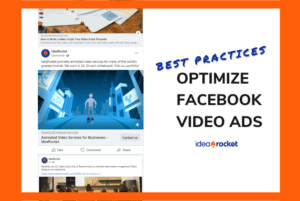Should you sell the problem or the solution? This seemingly straightforward question has plagued salesmen since the dawn of time. Is the best way to market yourself and your product by making consumers hyper aware of the problems they face via explaining the “pain point,” or will you make your mark by standing out from the crowd with a brand new solution? What’s the difference between selling the problem and selling the solution?
The way you answer these questions will inform your entire marketing strategy (like your explainer video) and shape how consumers see you and your brand. Are you part of the problem, or the solution?
The answer has everything to do with how crowded your industry is.
Sell The Solution: Stand Out In A Crowd
“When you’re in a mature market with lots of competitors, you main task is differentiate yourself from those competitors,” argues Creative Director and Idearocket founder, Will Gadea. “You have to pinpoint what it is that makes your solution better than the others in the market.”
Video is a fantastic way to differentiate your business from the competition, because you can highlight the features (and solutions) of your product in an easy to watch, interesting short video.
In a mature, saturated market, you always want to lead with your strongest differentiators. That means actually focusing on the specifics of your solution.
- What do you do better than anyone else?
- What’s the competition doing wrong?
- Why are you the needle in the haystack that customers need?
How To Sell the Solution: Differentiate
Selling the solution takes many forms, from highlighting new software or technological advances, or combining previously separate fields into a fresh takes on an old problem. Selling the solution means doing things differently, and when you rehash an old problem, you have to “disrupt” it with a bang.
Scandis, a furniture company in a competitive landscape, differentiated themselves not by talking about the quality of their furniture, but by explaining its unique business model and the many benefits that arise from it.
Scandis’ business is their hook, not their product. The “solution” is that customers can save money by working with a unique furniture shipping model. Problem solved.
Alcatel-Lucent is a global telecom company with plenty of competitors to choose from. In 2014, their strongest differentiator at the time was the ability to unify wired and wireless networks for large businesses. So that’s exactly what we dove into first.
There’s no reason to explain what the network solution is, so we immediately zero in on what makes their solution unique (also known as the unique selling proposition, or USP).
Selling The Problem: Startups & Innovation
Everyone loves to think their product or service is one of a kind: a special snowflake in the midst of boilerplate solutions. Sadly, most companies face a barrage of comparable competitors. In the rare occasion that you offer a truly novel solution, the best tactic is a counterintuitive approach: don’t start by selling your solution—sell the problem that people didn’t even know they had (until you came along to fix it).
“Oftentimes, startups like apps create a new space,” explains Gadea. “In cases like that, you have to spend a bit more time convincing people that they have a problem. Since your product is creating the new market, you don’t have to worry about differentiation.”
Dropbox is famous for their whiteboard explainer video selling the “problem” of digital cloud storage back before a 64GB iPhone was the “budget model.” Their video didn’t sell the innovative new features of their cloud platform because in 2003 no one knew what the heck a cloud platform was–or why they needed one. Now they’re one of the most successful tech companies in Silicon Valley, all thanks to solving a problem no one even knew they had.
According to VC David Bailey, the key to selling the problem is to “bring the message to life, using concrete and specific language and vivid metaphors.” Nothing says vivid metaphor like video.
Sell The Problem: Tech Startups & Apps
IdeaRocket got its start producing hand-drawn animated videos for tech companies. Many of these startups were trailblazing pioneers, offering a radically new solution that only recently became feasible thanks to new tech.
To this day, when we sit down with a new tech or app client, we simply ask:
- What are your consumers’ pain points?
- What challenge are you going to help them overcome?
If no one else has a fix, the consumers may not even know that they have a problem—you need to help them find it with an explainer video that sells the problem.
That’s the surprisingly simple formula that should dictate the opening moments of your video. If you have a novel solution, focus on the problem; if you’re in a competitive market, focus on how your solution is different.
Explainer Videos That Sell The Problem
StreetCred is a breakthrough product for law enforcement—there’s nothing else like it. As such, when we were condensing their value into a bite-sized explainer video, we first needed to spell out everything wrong with the status quo.
So we did just that: our whiteboard animation jumps straight into all the problems “Freddy” has on a daily basis: Disparate deskwork, inefficient organization, outdated filing systems, etc. At each turn, we see how “David” uses StreetCred to seamlessly solve these issues. It’s a classic example of selling the problem.
LeadID is a novel certification system for the lead generation industry. With no comparable competitors already in the industry, their video had to educate the audience about the existing problems as much as the actual solution.
The first 30-seconds showcase the current state of lead gen and why it doesn’t work. The target audience had become complacent. That’s always the way the lead gen business has been, so it wasn’t natural to itch for a fix. After the first third of the video, we’ve fleshed out their pain points: now they’re fed up and perfectly primed for the novel solution.
When Selling The Problem And Solution Meet
You’ll note that both of these videos still start by going a little negative—hitting pain points of competing solutions before standing out from the crowd. The formula we propose isn’t a hard and fast rule—it’s a sliding spectrum, a guideline to help steer the opener of your explainer video in the right direction.
Your solution may well fall somewhere in the middle, and that’s ok. Just remember to always consider the audience’s perspective. Will they be more interested in learning about the purpose of your offerings, or what makes yours different from all others? Once you know the answer to that, you’re ready to start selling.
To find out more about how you can succeed with animated video, download our free eBook and sign up for our monthly newsletter packed with tips, success stories, and video marketing news.




